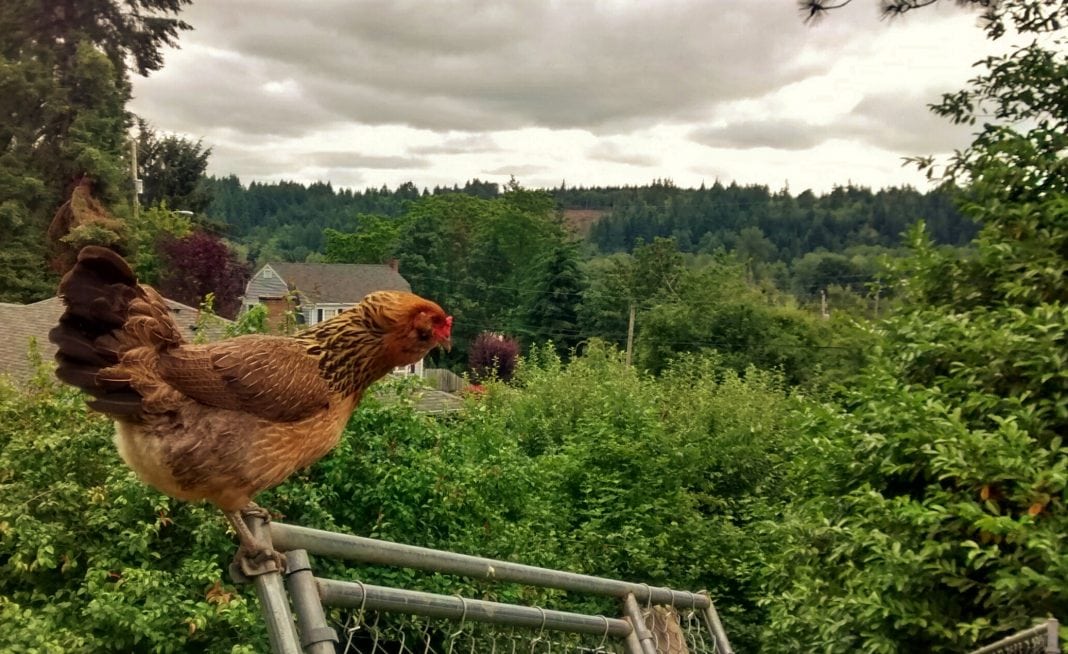For chicken enthusiasts everywhere, the bleak mid-winter is a dismal season for egg production. But there is hope around the corner. As the days wax longer, the eggs begin to appear in the nesting boxes once again. If you are interested in raising chickens for egg production, it’s important to understand the seasonal cycles of a  chicken. And a great source of advice on raising a flock is the local feed store. Many of the employees at The Farm Store in Chehalis keep chickens themselves, including Laurie Lowder, while owner Tom Christin used to have chickens on the farm. They are a wealth of information on setting up a chicken area, the right feed for the right time of life, and tips on how to get those hens laying eggs.
chicken. And a great source of advice on raising a flock is the local feed store. Many of the employees at The Farm Store in Chehalis keep chickens themselves, including Laurie Lowder, while owner Tom Christin used to have chickens on the farm. They are a wealth of information on setting up a chicken area, the right feed for the right time of life, and tips on how to get those hens laying eggs.
On February 22, the Farm Store will be getting their first shipment of chicks for the year. First things first, you must select a breed of chicken. “We’ll be getting in everything from the fancy little bantams to your all-year-long layers,” says Laurie.
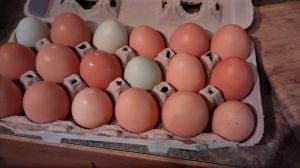
The Farm Store expects to stock a wide assortment of layers, including beautiful Wyandottes, showy Barnevelders, green egg laying Ameraucanas, Marans with their chocolate brown eggs and gentle Russian Orloffs to name a few. If larger eggs are of interest, they also stock baby ducks, and geese are available for special order.
For small eggs, bantams are a great choice. Bantams are shipped to the store assorted, so a wide variety will be available. The eggs may be smaller, but bantams are famous for being persistent layers and good brooders.
“We always had those around, and we would gather eggs for them,” says Tom. “They were our hens for hatching eggs because they are such good mothers.”
If you live inside city limits, it’s important to know your local codes concerning chickens and coop building. Some towns don’t allow roosters for example. But thankfully you don’t need a lot of space to raise chickens.
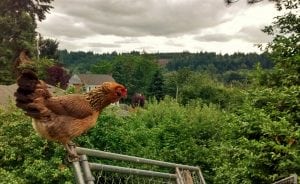
Laurie says it’s best to be prepared before you get your chicks. “So many people see them and they want them now and they have no setup. That can be detrimental to the chick,” she explains. “They don’t need any additional stress, and it doesn’t take much to be ready. They need a heat source, good bedding, food and water.”
“And be ready for the coming weeks” adds Tom, “because as they grow and get their permanent feathers, they are going to need more outdoor space and a secure coop.”
The Farm Store is your one-stop shop for everything you will need to take care of your little chicks, including coops, heat lamps and bulbs, feeders and waterers, shavings and feed. They stock both traditional and organic feed, including starter and grower feed, and feed specialized for egg production.
Purina is the brand of choice at the Farm Store because they have the years of research that goes into their feed. Tom has visited the research farm in Missouri on a few occasions where Purina raises chicks and chickens and he is impressed with the work they do there.
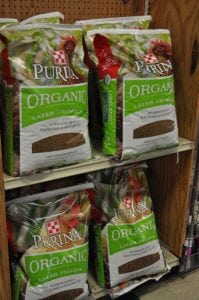
A variety of starter feed is available for baby chicks both medicated and non-medicated. Medicated feed helps to prevent coccidiosis in a chick’s digestive system. The medication is not an antibiotic nor is it absorbed into the meat of the chick. Probiotics are also beneficial for young chicks and is added to their water in the form of granules.
If you are adding chicks to your existing flock, it is best to wait until they are as big as your adult chickens and have their feathers, which will be when they’re about two months old. It’s also best to have a higher ratio of young chickens to your adult chickens as there will be a pecking order.
Young chickens start producing eggs around four to six months with proper feed and good housing. Layer feed like Purina Layena contains at least 16 percent protein and includes calcium, and a complete vitamin package. You can give your chickens treats and let them free range, but don’t overdo it. It’s important to make sure chickens are getting the protein and calcium they need so that their bodies aren’t depleted of vital nutrients during egg production.
Chickens will generally lay through the winter their first year, but by the following fall they will have their first molt and laying will cease for a few weeks or more.
“You want to give them that rest” says Laurie. “Some people prefer that rest; it makes a healthier chicken”
To help your chickens bounce back from molting feed them Purina Flock Raiser, which boosts their protein to 20 percent. Providing artificial light in the coop in the evenings, virtually extending their day to 14 hours also encourages laying. But sometimes laying proficiency comes down to age. There are only so many eggs in a chicken. In a lifetime, 200 to 300 eggs are normal, depending on the breed.
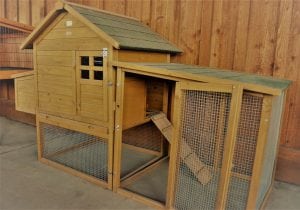
“The chicken business has changed,” says Tom. “It used to be they were raised for food, but now it’s more of a lifestyle. They have become more of a pet now. And people love watching chickens. I have customers who have them named and they know their personalities. It’s changed and the business has grown.”
“I think it’s helped people to all around live a better life,” adds Laurie. “For kids, it teaches them responsibility, to get them clean water and food, clean the pens and gather the eggs.”
The initial startup with chickens can seem like a lot of work, but once you get going keeping chickens is fairly easy. “And it’s fun,” says Tom. “People really enjoy chickens.”
Once you have your chickens, it’s time to enjoy the eggs!































